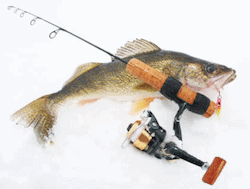Types Of Fishing Rods Explained
UPDATED 17 MAY 2023
by Robert Ceran
If you’re new to fishing, you may be confused by all the different types of fishing rods on the market, and what hat each of them is used for.
In the following article, we’ll give you an overview of the different fishing rod types, and then discuss each one in more detail.
So keep reading if you want to learn which types of fishing rods are best for beginners, which ones to use for different fishing applications, and what are the pros and cons of each one.
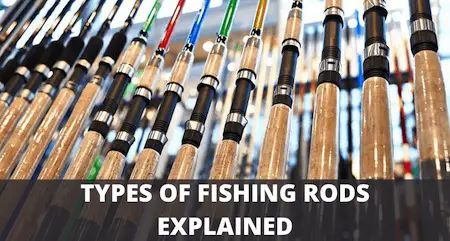
What are the types of fishing rods?
Here are the seven most common types of fishing rods:
- Spinning rods
- Casting rods
- Fly fishing rods
- Surf casting rods
- Boat rods
- Trolling rods
- Ice fishing rods
Now let’s look at each of these in more detail:
1. Spinning rod
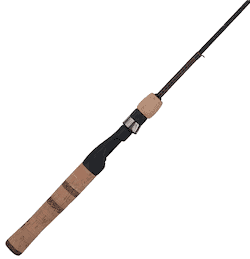
Spinning rods are one of the most commonly used fishing rod types and are great general-purpose models for beginners.
They are lightweight, versatile, and flexible, ranging between four and nine feet long. Spinning reels are attached to the underside of the handle, and all the line guides also face down.
Spinning rods are ideal for most fishing scenarios, and their casting technique is very easy to master without a lot of practice.
They are used for a wide range of applications in freshwater, where they can be used to catch all popular species, including bass, walleye, panfish, and trout.
They are also often used for inshore saltwater fishing.
The main drawback of spinning poles is that they don’t allow for a very precise cast.
This is fine for most beginners, but more experienced fishers often prefer casting rods, which will allow them more control over their lure placement.
If you’re into bass fishing specifically, check out our review of the top spinning rod for bass.
2. Casting rod
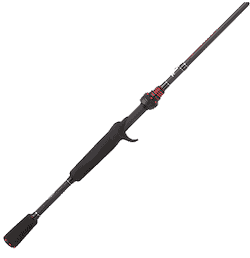
Casting rods are often compared with spinning rods, as they are used for many similar purposes.
They are usually heavier, and the reel is mounted on top of the handle, facing the angler, and the line guides are also on top of the pole.
Casting rods are divided into two subcategories: baitcasting models and spin-cast models.
here is little difference between the two variants; the only substantial difference is in the kind of fishing reel used with them. In general, spincast rods and reels are much easier to use than baitcasting rods and reels.
Casting poles are most well known for having a greater casting distance and accuracy compared to spinning rods, which is ideal for targeting a well defined area where you want your lure to land on the water.
For more details on this, check out our article what are the pros and cons of spinning rods vs casting rods?
While they can be used for many different techniques, and for catching a wide range of fish species, their most popular use is for bass fishing.
3. Fly fishing rod
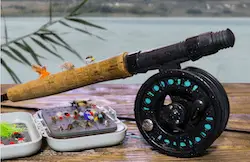
Fly rods are extremely lightweight, flexible, and adjustable, making them ideal for casting fly fishing line with very lightweight lures.
Fly rods are great for use in any body of water, even the ocean. They can be adjusted to handle different sizes and weights, making them ideal for catching almost any kind of fish.
Because they are so versatile, they are often a preferred choice among more experienced fishers. However, it takes time and practice to master the cast, and the cast requires a lot of space.
4. Surf casting rod
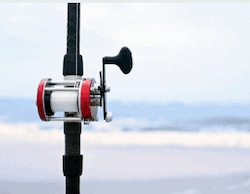
Surf casting rods are part of a larger family, known as sea rods, which are intended for use in the ocean.
They are generally very long, which helps to increase casting distance, and also tend to be made of durable materials to withstand the constant onslaught of ocean waves and saltwater’s corrosive effects.
Surf rods offer lots of different options for fishing from shore, small boats, or larger ships further out at sea.
Surf rods come in different sizes and thicknesses to account for the huge variety of fish you might find in the ocean.
Whatever size you choose, they are exceptionally durable, but they tend to be expensive and may not be necessary for the average casual angler.
5. Boat rod
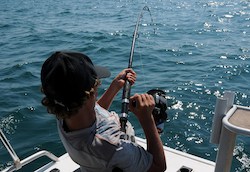
Boat rods are specifically designed for deep sea fishing. They are generally short, since you just need to lower your hook and weight over the side of the boat, with no need to cast it.
In addition, they also tend to be very stout and heavy duty, made of solid fiberglass.
This is because you can expect to catch some very big fish while deep sea fishing, and need enough power to pull them up from a great depth.
For the same reason, boat rods are designed to be used with conventional reels that can hold a lot of heavy line.
6. Trolling rod
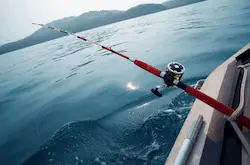
Trolling rods are durable and heavy-duty, made for use on boats. Specifically, they are mounted in a holder at the back of a boat, which moves slowly through the water, causing the lure to “swim” and catch the attention of any fish in the area.
Trolling rods are mostly used for catching larger species of fish, such as tuna and marlin.
They are not as widely used as the other types of fishing poles on this list, but they may be useful if you do a lot of fishing from boats, either in lakes or oceans.
For examples of trolling rods, check out our review of the best trolling rod for salmon.
7. Ice fishing rod
Ice fishing rods look similar to spinning rods, but they are the shortest types of fishing rods, sometimes only two to three feet long.
They can be used with spinning reels, or you can use an inline reel model designed specifically for this purpose.
Ice rods, of course, are only intended for ice fishing. Because of their small size, you won’t get much of a cast off of them.
They are meant for use in a confined space inside an ice fishing shelter, and for lowering your lure or bait through a small hole in the ice.
Ice rods are only useful for catching small to medium fish species, up to the size of walleye and pike. Larger species could cause the rod to snap.
That said, they are fairly inexpensive. They are also super easy to use since you don’t have to know how to cast–simply lower your line down through the hole in the ice.
What to look for in a fishing rod
Now that you have an overview over the different types of fishing poles, let’s discuss what features you need to pay attention to when buying a new pole.
Telescopic rod vs two-piece
Spinning and casting rods come in two different variants: telescopic or two-piece rods. The main difference between them is that telescopic poles can be folded down into a very short and compact form, which is ideal for traveling.
However, the performance of telescopic rods is generally not as good as that of two-piece models, since each piece has to be small enough to slide into the previous piece, which puts constraints on the taper and backbone performance.
In general, telescopic spinning rods are great for beginners, since they are very easy to transport, assemble and use, while more experienced anglers prefer two-piece poles due to their superior performance.
Rod size
Rod size (also referred to as weight) is usually written next to the handle, and is given as the recommended line strength and lure weight to be used with it.
So once you know what kind of fishing you want to do, you should choose a rod size that works best for that purpose.
You should also pair it with a reel designed to handle the same line strength and lure size (for more information on reel size, check out our article on spinning reel sizes).
Rod action
Fishing rod action refers to the amount of flex the rod has when it is bent. In general, a pole can bend along the whole length of its backbone (slow action), or only at the tip (fast action).
- Fast action: bends only at its tip
- Medium action: bends halfway along its length
- Slow action: bends along its whole length
In general, types of fishing rods that are used for throwing lures tend to be fast action, since this results in better casting distance and accuracy.
Boat rods and trolling rods, on the other hand, tend to be medium or slow action, since their greater flexibility helps to fight big fish.
For a more detailed discussion of this topic, check out our article: fishing rod action explained.
Rod power
Rod power is often confused with action, since both terms refer to its bending behavior.
But while action refers to where along its backbone the bending occurs, power refers to how much force is needed to bend it. In other words, power refers to the resistance a rod has to being bent.
- Heavy: requires a lot of weight to be bent
- Medium: requires intermediate weight to be bent
- Light: bends very easily
In general, the bigger the fish you plan to catch, the heavier the power should be. On the other hand, fishing for small species is more fun with light power, which allows you more sensitivity.
To get a deeper understanding of this topic, and how to choose the right power rating, take a look at our fishing rod weight guide.
Rod material
Fishing pole blanks are made of 3 main types of materials:
- Fiberglass
- Graphite
- Composite
Fiberglass has been around the longest, and has the advantage of having more power and being more durable, which is ideal for heavy duty saltwater fishing.
The strongest sea rods are made of solid fiberglass, which is almost impossible to break. This is ideal for trolling rods, especially when using downriggers.
Graphite was introduced more recently, and has the advantage of being much lighter than fiberglass, as well as being stiffer. These two properties make it ideal for any applications which require accurate casting of a lure or bait.
The lightness also helps to avoid casting fatigue if you fish many hours in a row, plus it’s ideal for ultralight fishing applications.
On the downside, however, graphite is more brittle than fiberglass. Because of this, graphite rods break a lot more easily under strain than fiberglass ones, which can be a problem if you hook a much bigger fish than expected.
Composite materials (as the name suggests), combine both graphite and fiberglass, which can result in combining their strengths, while avoiding their individual weaknesses.
The most famous example of this are the Shakespeare “Ugly Tech” rods (for an example of this, check our review on Ugly Stik GX2 vs Elite).
Handle material
Rod handles are usually made of either cork or EVA foam. Both of these are great for most purposes, so the one you choose basically boils down to your personal preference.
It’s important to note, however, that some cork handles are made of pressed cork, which is not as durable and high quality as real cork.
Line guides
Line guides can vary a lot depending on the type of rod you choose. Casting rods have smaller line guides that sit on top of the rod facing the angler. They also tend to be of uniform size along the whole length of the pole.
Spinning rods, on the other hand, have bigger line guides towards the base of the pole, while the guides get smaller and smaller towards the tip.
Line guides are usually made of stainless steel, and often they have inserts such as zirconium or alconite, which helps to reduce line friction.
Heavy duty trolling and boat rods have a rotating insert inside the top most line guide, which also helps to prevent line breakage due to friction, especially when fighting big fish.
Conclusion
And there you have it – these are the most popular types of fishing rods. At this point you should have at least a basic understanding of each type of fishing rod and its different specialties.
So the next time you head to your local fishing shop, you’ll know which type of rod to buy for your specific purpose.

